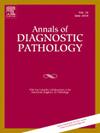浸润性肺非粘液腺癌的肿瘤形态和组织学模型的数字图像分析及其预后评价。
IF 1.4
4区 医学
Q3 PATHOLOGY
引用次数: 0
摘要
2021年世界卫生组织肺腺癌分类是基于高级别组织学模式的优势和百分比,例如实体和微乳头状模式,通过半定量估计确定。数字病理学可以用来评估每个模式的面积和计算准确的百分比。利用数字病理学评估浸润性非粘液腺癌组织学模型的预后预测能力。本回顾性队列研究纳入了2010年1月至2016年12月在Songklanagarind医院行肺切除术的76例侵袭性非粘液肺腺癌患者。使用QuPath Open软件版本0.3.2在数字载玻片上测量组织学模式面积。收集临床和病理资料,包括肿瘤通过气道扩散、肿瘤坏死、肿瘤浸润淋巴细胞和淋巴血管浸润。主要终点是5年总生存率。采用Akaike信息准则给出最佳模型,并通过识别受试者工作特征分析中的曲线下面积(area under The curve, AUC)与前人研究中其他模型的预后判别能力进行比较。采用自举法对最佳模型进行了验证。最佳模型是分期和82%的截断高级模式的组合(AUC = 0.776)。≥82%高级别肿瘤的预后明显差于高级别肿瘤的预后(p = 0.001)本文章由计算机程序翻译,如有差异,请以英文原文为准。
Digital image analysis of tumour pattern and histological models for prognostic evaluation of invasive non-mucinous adenocarcinoma of the lung
The 2021 World Health Organisation classification of lung adenocarcinoma is based on the predominance and percentage of high-grade histological patterns, e.g. solid and micropapillary patterns, determined by semiquantitative estimation. Digital pathology can be used to evaluate the area of each pattern and calculate the exact percentage. To evaluate the prognostic predictive ability of a histological model for invasive non-mucinous adenocarcinoma using digital pathology. This retrospective cohort study included 76 patients with invasive non-mucinous lung adenocarcinoma who underwent lung resection at Songklanagarind Hospital between January 2010 and December 2016. The histological pattern area was measured on a digital slide using the QuPath Open software version 0.3.2. Clinical and pathological data, including the presence of tumour spread through airspaces, tumour necrosis, tumour-infiltrating lymphocytes, and lymphovascular invasion, were collected. The primary outcome was 5-year overall survival. The best model was provided by the Akaike information criterion, and the prognostic discrimination ability was compared with that of other models from previous studies by identifying the area under the curve (AUC) in the receiver operating characteristic analysis. The best model was validated using bootstrapping. The best model was a combination of stage and an 82 % cut-off high-grade pattern (AUC = 0.776). Tumours with ≥82 % high-grade pattern resulted in significantly worse prognoses (p = 0.001) than those with <82 % high-grade pattern. Our model had the highest AUC among all models from previous studies. This was validated using bootstrapping, with an AUC of 0.708. The best model for survival prediction was a combination of stage and an 82 % cut-off high-grade pattern.
求助全文
通过发布文献求助,成功后即可免费获取论文全文。
去求助
来源期刊
CiteScore
3.90
自引率
5.00%
发文量
149
审稿时长
26 days
期刊介绍:
A peer-reviewed journal devoted to the publication of articles dealing with traditional morphologic studies using standard diagnostic techniques and stressing clinicopathological correlations and scientific observation of relevance to the daily practice of pathology. Special features include pathologic-radiologic correlations and pathologic-cytologic correlations.

 求助内容:
求助内容: 应助结果提醒方式:
应助结果提醒方式:


